It All Starts With a Plan . . .
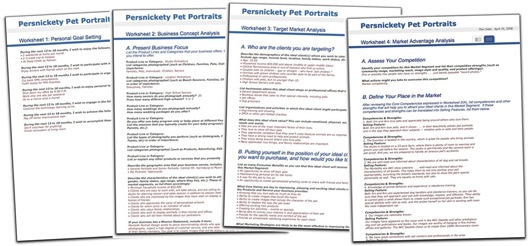
Timing is everything they say, and the timing was perfect last spring when Jim and I began to plan our new business venture: Persnickety Pet Portraits. Our planning coincided with my development of a worksheets for Marathon’s new Strategic Marketing Plan Workshops. So I decided to use Jim and myself to test the process. First, I had Jim complete all 12 of the work session worksheets to assure that the questions were easy to understand. Then I completed the 12 worksheets myself. Finally, we worked through the worksheets together to iron out any differences we had in our approach to creating the new business.
I can’t say enough about how valuable this process was in helping us to achieve absolute focus on the task at hand; Jim and I have built two businesses together: The first one—Countryhouse Studios in Annville—could rightly be called a monument to planning failure; but we had learned our lesson when we created a strict financial and marketing plan for the Monteith Portrait Studio and Gallery in Lancaster. Using the worksheets to help us plan Persnickety, however, made our work so much more focused and in the long run a great deal easier, because it covered on all the elements necessary to build a meaningful brand, and I am far more confident that the marketing strategies and materials that we selected will be effective and will truly add meaning to that brand.
The process itself assures that you stay focused on the brand you are building by asking you a series of questions contained in a self-extracting computer application that Marathon helped me to develop. Each worksheet tackles a different marketing issue, and when they are completed, the worksheets can be printed out (as you see from these illustrations) so that you have a reference document in front of you to keep you on task as you implement marketing strategies. By the time you have completed the process, any copy you will need for marketing pieces is virtually written for you in the form of “selling points.” These worksheets, of course, are what Mark Weber and I use during the work sessions at the Strategic Marketing Plan Workshops that we teach together. The next workshop is scheduled for May 18 and 19 in Minneapolis, and I strongly recommend that if you are struggling with any aspect of marketing your business, this workshop will put you on the right track. I can assure you there is no more effective resource in the industry.
Getting your marketing act together is especially important during challenging economic times, when the tendency is to “pull back” because the market is uncertain. What I learned during the recession that was on when we started our Lancaster business is that my marketing was doubly effective, because competitors were lying low. Ironically, the recession actually improved our visibility in a new market.
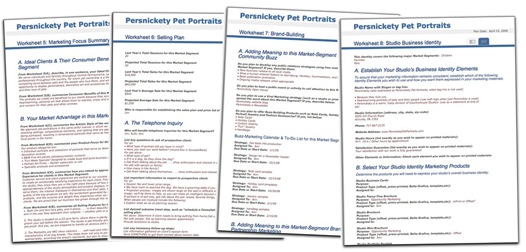
An example of one of the work session exercises is the completion of three strategic directives about your business that will help you to stay on course when you are marketing. These three elements our briefly explained below, and I have included the actual statements I developed for Persnickety Pet Portraits after going through the process.
Building a Mission Statement
The purpose of a Mission Statement is to help the business stay on course. Well-managed organizations look to the company’s Mission Statement when approaching strategic decisions by asking: Will this action be consistent with our Mission? A Mission Statement contains the following elements (in any order): the business purpose (the opportunities you address); the business itself (what you do to address these needs); and the values (principles or beliefs that guide your business).
Persnickety Pet Portraits Mission Statement
Our mission is to reflect the joy pets bring to the lives of our clients through personalized, decorative art and accessories that honor the compelling bond between pets and the people who love them.
Establishing Your Sustainable Competitive Advantage (SCA)
The purpose of a Sustainable Competitive Advantage is to summarize how the business intends to survive against competition over time. A Sustainable Competitive Advantage is derived from an organization’s Core Competencies—those areas of specialized expertise that:
- Provide specific consumer benefits.
- Are difficult for competitors to imitate.
- Are capable of developing new products and services.
Persnickety Pet Portraits Sustainable Competitive Advantage
- Our photographers are nationally known for their skill and artistry in creating exceptionally pleasing, heartwarming portraits of pets and the people who love them.
- We understand why pets are so important to the lives of our clients because we are pet lovers too.
- We are experienced dog handlers, and we understand cat psychology.
- We create custom heirloom-quality portrait art rather than cutesy calendar-style photos.
- The studio and grounds are totally pet-friendly.
- Our business has grown through the referral of satisfied clients.
- Something WONDERFUL is always happening at Persnickety!
Creating Your Unique Selling Proposition (USP)
The purpose of a Unique Selling Proposition is to sum up why consumers should purchase from you rather than others. Written in sentence form, it should be brief, succinct, and compelling enough to persuade consumers to give you a try. Much of the content of your USP is likely to be derived from your Mission Statement and Sustainable Competitive Advantage; but this statement must contain persuasive marketing content as well.
Persnickety Pet Portraits Unique Selling Proposition
Through our unmistakable expertise in photography, our comprehensive knowledge of pet behavior, and our proven ability to earn the respect of our clients, it is our pleasure to honor the compelling bond between pets and the people who love them by creating personalized decorative artworks designed to touch the heart and warm the home.
In future posts, I will be showing other marketing pieces that grew out of these strategic directives as well as the plan Jim and I created. I believe that they will help you to recognize just how valuable the process was in helping us to refine our marketing focus.
Creating a Marketing Foundation: Getting Started

I’ve observed that most studio owners start to create marketing pieces before they have a well-formed business concept, a focused market target, and an appropriate business identity. Typically, when this happens, it becomes impossible for the studio to build a meaningful brand that gets the business recognized by the desired clientele. Therefore, long before the “foundation” marketing piece for Persnickety was conceived, Jim and I completed a marketing plan that covered the three vital elements I just mentioned. I’ll be explaining these steps and other planning aspects in future “About Persnickety” posts, but I wanted to show you the piece first, so that you can see the result of this important process.
I got the inspiration for our piece from a nifty mailer that Sarah Petty designed for Marathon’s BellaGrafica line; she sends hers to new parents, and you can see the piece by clicking here. My mailer does not use the die-cut window, but what I love about the design is it’s interactive feature: the recipient has to unfold each of the four flaps in order to view the images and read the message on each, then inspect the inserts that rest in the center portion of the marketing piece.
The illustration above shows how the piece appears when it is removed from its envelope. The two images below show the outside and the inside of the mailer.


This mailer is more expensive than the cards or brochures that I have used as client acquisition pieces in the past; but I’m confident that it will be cost-effective for numerous reasons:
- It will be mailed to a highly targeted list of names provided to us by several local pet professionals who have identified their most qualified clients.
- It’s pretty hard not to notice a marketing piece this intricate.
- I’m using an appealing offer (a $100 gift card), which should attract attention of people who have seen our work hanging in the stores and offices of places they frequent with their pets.
- Some of the mailers will be used as handouts at an open house and for members of a local dog training club in which we participate.
- The piece is quite versatile, so it can be used for purposes other than client-acquisition mailings, and I will explain each by way of the illustrations shown below.

Here’s how each of the inserts will be used:
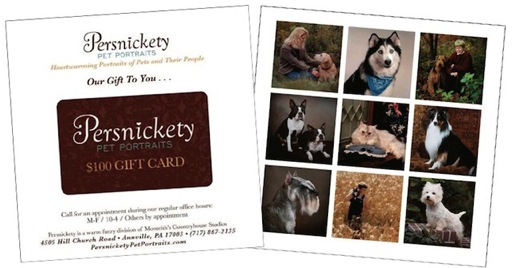
The insert shown above is what the target-list recipient will see when the mailer is opened. It contains a glue-dotted laminated gift card for $100. Because we have a well-established reputation in the community for our pet portraits, I believe this will be an effective motivator for the clientele we are seeking to attract.
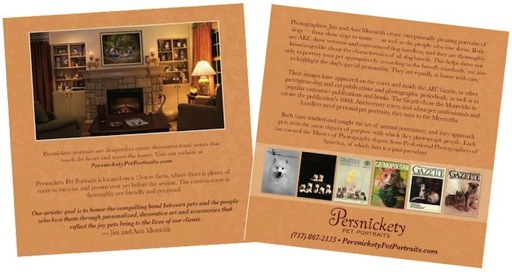
This insert will be included whenever the marketing piece is used, as it contains information about our business: the fact that our product focus is wall decor, as well as information about our accomplishments as pet portrait specialists.

This handy insert will be used as a note card, and it will be helpful for fulfilling requests for information or for other occasions in which a hand-written note is appropriate.
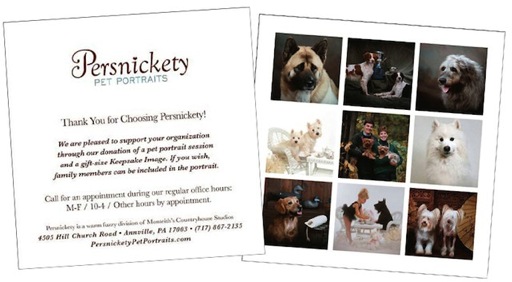
The final insert from this printing is one that will be used to fulfill requests for charitable marketing. We will provide each organization with 10 to 20 of the folders that include the insert that they can sell to attendees at their fund-raising event at a price they designate: we suggest that they consider a price between $20 - $50 to assure that all certificates are sold. The purchaser will receive a portrait session and a small “keepsake” portrait; and the charity must agree to provide the studio with a list of names of the purchasers so that we can get in touch with them to redeem the certificate.
But wait, there’s more! The folder also will serve as a “jacket” to house the circular Persnickety gift certificate shown below.

The certificate is a two-panel circular note card format that is part of the mPrint press-printed product line. Click here for more information.
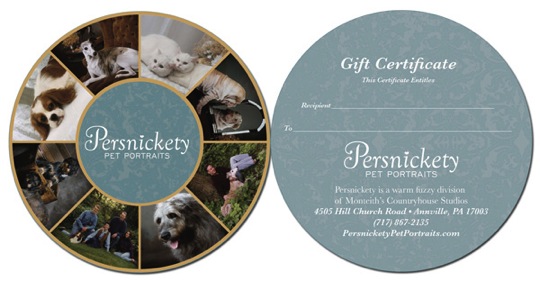
And here’s the back, which repeats the design of the inside of the gift certificate, but using different images.

So I’m pretty excited about the look of the piece and how we’ll be able to use it for all these varied purposes:
- A mailer and/or handout for client acquisition
- A fulfillment piece for information requests
- An insert that can be used for hand-written correspondence
- A client education piece to use during planning sessions for portraits that include people
- A handout to donors who purchased a session and gift-size image at a charitable event
- A “jacket” for our circular gift certificate
Polinomics 101: A Big Week for Federal Follies
- Never mind that this $165 million payment represents only one-half of one percent of the recent Congressional Spending Orgy.
- Never mind that the Congressional Budget Office reported that the budget deficits will average almost $1 trillion a year over the next decade, which is $2.3 worse than the administration is predicting.
- Never mind that the guy they are now blaming for knowing about the bonus debacle (Treasury Secretary Timothy Geithner) is the same guy that couldn’t figure out his self-employment tax when his employer sent him a cheat sheet on how to do it; that was O.K., but knowledge of the unpopular bonuses . . . oh no!
- Never mind that Mr. Geithner is home alone, with no assistants in the Treasury Department to help because of now-impossible ethics hurdles.
- Never mind that the issue of the toxic assets that pollute the financial system continues to languish.
- Never mind that while no one was looking, history was made on Thursday, when Federal Reserve Chairman Ben Bernanke printed $1TRILLION so that the Fed can begin buying debt from the Treasury; yes . . . that means moving money from one pocket to another; so Bernanke is either a world class genius or scarier than Alan Greenspan.
- Never mind that it was New York Attorney General Andrew Cuomo who uncovered the bonus mess by reading the documents that the media failed to read and report on . . . and it looks like he’s still diving for the iceberg itself: if you want to know who did what at AIG, log on to Cuomo’s Media Center section of the AG website.
- Never mind that the media still refuses to investigate the tough and most relevant question: the relationship between government and our failing financial institutions.
The Congress-Members-as-Populists-Parade was really quite a sight to behold this week: almost as interesting as watching a wild-west sheriff try to clean out the whorehouse by shooting the piano player.
Stay tuned . . .
It's Not Like I've Never Seen Promotions, But . . .
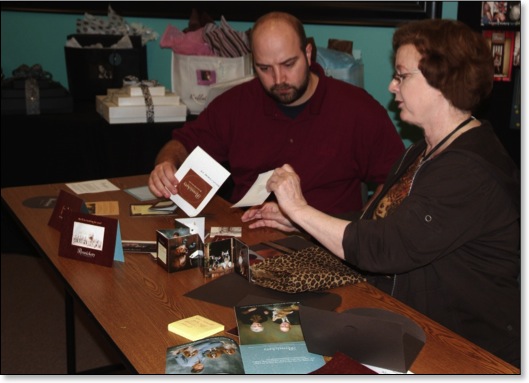
During last week’s meeting at Marathon, I got a look at proofs of all the marketing materials now in production for Persnickety Pet Portraits, Jim’s and my new business venture, which will open in late spring, or as soon as we get some studio renovations finished. The contractors were here this week to take a look, and I’m eager to hear what they have to say, as we are going to stick to a very strict budget on this project. Then there’s the business of clearing out the place first: not fun to think about, but it will be a load off my mind and a real sign of progress when it’s finished.
Getting to see the new marketing pieces was itself sign of progress, but this one was really fun . . . as usual. I’m shown here with designer Brian Headley, who did the initial designs for Persnickety. After all these years, it’s still a blast to see new pieces as they develop—especially when they are mine :-). As I said when I started this series of posts on Persnickety, I decided to keep a record of all the steps involved, because I’ve observed that most people underestimate the amount of time and preparation it takes to build a business and get the marketing off the ground . . . especially when you’re busy tending to current business issues. In the next few posts, I’m going to show off the “foundation” marketing piece for Persnickety and explain what had to be in place before we could get started designing it.
Getting Objectives in Order . . .
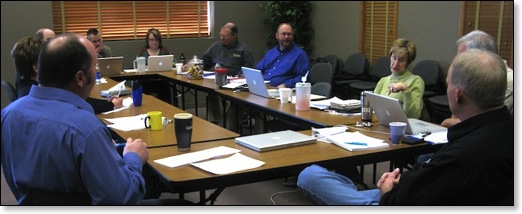
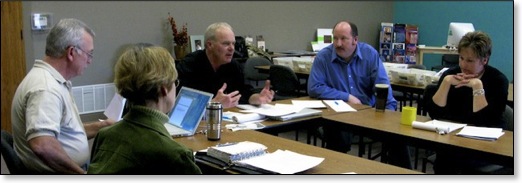
I often hear people refer to “The Marathon Family,” and rightly so because of the warm atmosphere generated by the organization. In the photo below, you can see three real generations of that family: Marathon founder and chairman Rex Alewel with his daughter Leah Fineran, who works as an account rep in the firm’s commercial division, and Leah’s daughter Madelyn. Leah and Maddie joined Grandpa Rex for lunch during our meeting.

On our agenda during the two-day meeting was planning the upcoming Strategic Marketing Plan Workshops, the first of which will take place in Minneapolis, MN on May 18-19. I’m shown below with my fellow workshop road warriors, from left, Bill Camacho and Mark Weber.
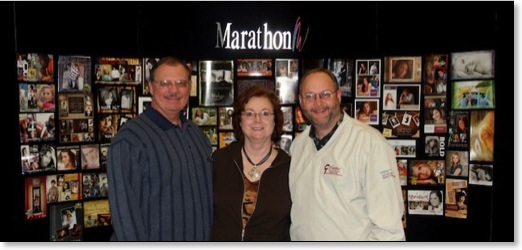
Back to Basics
The Challenging
The potential for a wave of consumer optimism that sometimes accompanies the election of a new president—one that I believe was universally hoped for by both Democrats and Republicans—has failed to materialize. It has been overwhelmed by a free-falling stock market as well as news of banking chaos, business closings, job losses and political rancor. Until consumers get over their fear of the unknown—or learn to live with it—most businesses, including photographers, will be in for a struggle.
It doesn’t help that the explosion of new photographers in the industry over the past five or so years has created chaos for both photographers themselves and for consumers who are bewildered by marketplace extremes in pricing and business practices. The addition of so many newbies in such a short time has destabilized the industry because it has escalated the number of fragile businesses in several categories: hobbyists who don’t care about being profitable as long as they are bringing in a few bucks; wannabes who don’t know what’s up; once-profitable businesses that have not responded properly to increased competition, old-time businesses that are in decline; newer businesses that are just holding on; and marginally profitable part-timers who would collapse if they went full time prematurely.
Economic downturns always shine light on one of the real downsides of running a small business: Most small business owners in distress have fewer jobless benefits than company employees. This is especially concerning at a time when health care premiums for non-group plans are increasing dramatically.
The Uncertain
The possibility of a bipartisan approach to solving economic problems appears to be doomed. In its place I believe we have entered into an era of heightened “polinomics,” in which we will witness an epic struggle between two long-standing ideological factions: the proponents of big government as the solution to economic pain and those who believe that private enterprise is the best engine for creating economic growth. The outcome of this struggle is likely to determine the length of the current recession and possibly even the future character of America and Americans. Of all the challenges we face, this causes me the greatest concern because it most directly affects the future of small business and the economic legacy that we pass on to our children and grandchildren. I fear that hastily adopted, short-term economic solutions are most likely not the best long-term solution for America. This is, I believe, the lesson of history, and it is being obscured because of a willingness of bureaucrats and citizens alike to accept that we are “in uncharted territory.” Several months ago I pretty much thought this to be true, but that was before I started digging into economic history. This is something I hope many small-business people will do, then draw their own conclusions and make their voices heard to their elected representatives. I say this because I am just cynical enough to believe in the wisdom of the well-known quote of economist Thomas Sowell:
The first lesson of economics is scarcity: there is never enough of anything to fully satisfy all those who want it. The first lesson of politics is to disregard the first lesson of economics.
In the brave new world of polinomics, few things are clear except for the fact that politics and economics always make uncertain bedfellows, especially for those who are sleeping on the floor and kept awake by their snoring.
The Hopeful
- This might sound strange, but I believe that the very best news there is for the professional photographic industry is the fact that most—and I do mean most—photographers are not very good at business simply because they never try to be. When they get over their fear of, their loathing for, or their indifference to business principles and finally start to learn what they need to know, their progress can be stunning. I see it all the time. Every week I get encouraging emails and notes from students who have achieved impressive successes because they grasped the tools they were given in class and did nothing more than put them to work. So I am convinced that many photographers can move forward during this recession by reading a book or taking a class or implementing well-known success strategies that are not as much fun as trying new photographic techniques or buying more photographic stuff.
- Small businesses have greater flexibility and can more easily adjust to changes in the economy than their larger counterparts. You probably know people whose jobs have disappeared or who recently received pink slips tucked into their paychecks. They have far fewer options than those of us who have learned to work by our wits. Even though the marketplace for photographers may be difficult for a while, we can change directions, use our creativity, and start thinking outside the box. This may mean cutting back regular studio operations several days a week to save on expenses and use other skills to get different kind of business, such as helping families to create decorative wall groupings from their family portraits and snapshots. And recognize that you can cut back your expenses a lot more than you know. So take a deep breath, push away the tendency to panic when your phone is not ringing as much as usual, and make use of the character-trait advantage that self-employed business people have over those who depend on others for their livelihood: self-reliance. You have more options than you think.
- I’ve always believed in the business premise that you should never underestimate the value of a good crisis . . . another way of saying that when the economy gives you lemons, open up a lemonade stand. The fact is that smart business owners view a crisis as a wake-up call to buckle down, refocus, assess options, recognize opportunities, and restructure for future profitability. I know this to be true because Jim and I opened two businesses during recessions, and we bought our vacation home on the tail-end of another, as we saw its potential as a rental property. Was any of this easy? No. But it was possible because we learned from past mistakes, worked the current problem, and didn’t panic. Perhaps we were too tired to panic :-).
- One of the harsh realities of a recession is that some businesses will not withstand it; but it is also a fact that the “pruning of the business tree” infuses life in the ones that are left. This is bound to happen in the photography industry.
- One of the often-overlooked benefits of a recession is that local business people who trade with a similar market are often more willing to engage in partnership marketing than they might be otherwise. So seize the initiative and invite several non-competing vendors to go to lunch with you to talk about cooperative marketing ventures, such as a charity event or a “night out” that will lift people’s spirits and call attention to your businesses.
- The best way to make the most out of times when people are down in the dumps or shell-shocked by media scare-mongering is to reach out and touch your clients. Take a few loyal clients to lunch to see how they are doing. Ask their opinions about new directions you are considering for your business. There is nothing more valuable than seeing through the eyes of an intelligent, caring person who is interested in what you do. As my good friend and Marketing Goddess Carol Andrews often says: “You can’t read the label when you are inside the bottle.”
Recently I’ve been asked the same question over and over: What should your marketing message be when consumers are fearful of the future? In my opinion the answer to that question is no different from what it should be in good times: It’s the value of thoughtful, artful photography in the lives of the families we serve. People know this, but they forget it until the water is rising or the brushfires are threatening, and inevitably the first belongings they pack are their family photographs. In bad times and good, we have to be better storytellers, because the benefits of what we sell are so much easier for the heart and the mind to recognize than all the “stuff” that so many retailers have a hard time defending during a recession.
At last month’s Studio Management Services workshop in Atlanta, Carol Andrews brought along a full newspaper page ad for De Beers, the diamond company of “A Diamond Is Forever” fame The ad talked about “ living in different times,” and the importance of “fewer, better things.” They clearly understand how to communicate the value of a product that last and grows more valuable every year. This sentiment could just as easily describe the portraits that comprise the history of a family.
Last Saturday I spoke to my blogging buddy Carrie Viohl, who called my attention to a wonderful Allstate TV commercial that delivers a similar message . . . about how families get “Back to Basics” during hard time. It is illustrated with photographs, and in my opinion it reflects the perfect message for us to convey to our clients and for ourselves to take to heart about our businesses. If you see through these eyes, I believe you’ll conclude that we all have a lot going for us.
As the Allstate ad says: The basics are good.
Need Business Help Now?

If you can’t afford to wait any longer to achieve business success, act now and you can grab one of the few spots remaining in the April 24-27 Guerrilla Management Workshop.
There are no shortcuts to business success, but I’m very proud of the highly focused success path that my teaching partner Judy Grann and I have developed through our Guerrilla Management Workshops. It is wonderful to know that many of the industry's top performers credit Guerrilla Management with putting them on the path to financial success and helping them to achieve more leisure time. This intensive hands-on workshop can do the same for you if you are serious about your business: We will help you to see where to make the changes necessary to control the present and future direction of your business.
Workshops are limited to 15 studios to assure plenty of interaction. To learn more about this profit-producing workshop, click here. You'll learn what we do in class, why we get such good results, what graduates have to say about their experience, and so much more.
To register, call 1-800-842-2349.
Outside of the US, call 1-717-867-2135.
What to do During Recession? Start a New Business!

Some readers of this blog at a lot of my students know that since last spring, Jim and I have been working on a new business that we plan to open sometime this spring. Last April we made a commitment to narrow the focus of our business to the product line that we like best: pet photography. We agonized over a name for several months and finally settled on Persnickety Pet Portraits. It was a relief to come to all of these decisions; you’ll understand why I said this if you work with a spouse or partner :-).
The current economic climate has not forestalled this decision; after all, we opened our first two businesses (the Annville studio and the Lancaster location) during recessions. After the struggle we experienced in opening Countryhouse in Annville, you might wonder why we forged ahead in Lancaster. Well . . . by the 1982 recession, we had learned what we needed to know about business: how to create sales, sessions and expenses forecasts for the new venture; how to minimize risk by purchasing a building with a good rental history and using only a small portion of it for our business; and how to get the attention of the market we were seeking to attract. We are following similar strategies as we scale down the Annville studio to actively market only for pet portraits, while continuing to service clients of long-standing in other product lines.
Building a new business takes more time than you might expect, so I decided to start a series of blog posts to record the the step-by-step process of creating Persnickety in the hope that some readers will find this feature to be instructive. This is the first of these posts.
Among our overall goals in starting Persnickety was to minimize risk through careful planning and accurate budgeting. The planning began last April when Jim and I ran the numbers then put ourselves through the same process that Mark Weber and I teach at the two-day Marathon Strategic Plan Marketing Workshop. I’ll be writing more about our 2009 workshop schedule shortly.
So creating a business plan that is both on paper and in our heads was step one, because nothing minimizes risk and keeps you focused better than a plan.
Step two was to hire a contractor who was willing to do some exterior upgrades to the studio for a good price while he was between jobs.
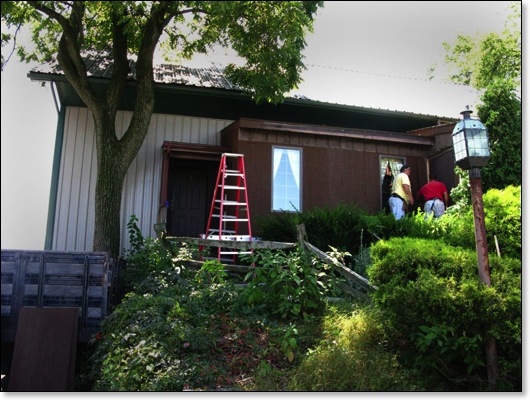
Last fall, I had Marathon create a dedicated website for Persnickety. I chose one of their HTML Packages that cost only $495, and I didn’t have to do anything other than provide the photographs and copy. It did take me a long while to round up all of the images (I ordered three extra galleries to the site), but the good news was it took less than two weeks for Marathon to have the site up and running, and I was delighted with the results.

In November, we took delivery of a new sign (see top image) that incorporated the Persnickety identity but doesn’t lose the brand equity that we had achieved through Countryhouse.
The next step? Most all of our Persnickety marketing products have been designed, and they will be printed shortly. As each is finished I will present it and explain the strategy behind it, and I also will talk about the strategies that are part of our overall marketing plan to get Persnickety off the ground. I hope you will this series as much as I have enjoyed starting this new venture.
Cultivating Plans

When not handling Marathon business, Rex is the hands-on owner of a tree farm that surrounds his Missouri home. It is a fascinating operation: Rex farms Paulownia trees, which I had never heard of until I visited the farm last July. This amazing species originally came from China, and because it is remarkably fast-growing and produces a lightweight yet dense wood, is said to be “the new timber tree of the 21 century.” The farm comprises 11,000 trees spread over 9 different fields on 115 acres. Rex intercrops three of the larger fields rotating corn, beans, and wheat. These fields average 80 trees per acre; most of the remaining fields have 120 to 155 trees per acre with medium red clover planted between the rows, which allows him to bale clover two or three times a year.
Paulownia lumber is really beautiful: it is light straw colored, much like ash, with a very straight grain. Besides being a renewable resource, the lumber is prized by wood workers because it does not crack, warp or split, is fire resistant, and it is an excellent insulator of heat or cold. Its machinability is excellent, and it stains, glues and paints with ease.
In a year’s time a field-planted Paulownia tree can grow to between 12 and 15 feet. The field shown below, which I photographed last July had been growing for 14 months from 4-year-old stumps that had to be cut down after a heave late frost in April of 2007. Paulownia trees can start over from the stump every time you harvest for about 50 years.

Rex says that when the trees are mature and their leaves reach out to touch one another, they look like giant umbrellas that completely shelter the ground below, which creates a magical room-like environment when you walk through the field. The image I took of Mark at work photographing the leafless trees shows that the branches actually have the appearance of an umbrella-like structure. If you wish to learn more about Paulownia trees, click here and here.

The Paulownia trees seemed to me to be an apt metaphor for the work that Mark and Rex and I were doing: creating plans. Any kind of business planning is like the process of growing a crop. You have to establish it with care, then cultivate it; you can’t just leave it out there and expect it to grow into a bountiful harvest all on its own.
Here’s farmer Rex, and his wife, Natalie.
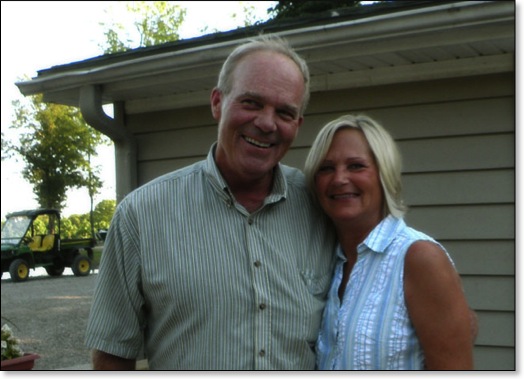
And I couldn’t conclude this post without giving you a look at Rex’s loyal dog Lucy. If he parks his four-wheel drive Mule anywhere near the house, Lucy will sit next to the driver’s seat and all day waiting for a ride. Do you see why pets are my favorite subject?

Confessions of an Economic Conservative
By then a streak of 60’s idealism convinced me that I wanted to become a senior high school English teacher, and my practicum experience teaching 11th and 12th grade English exceeded my hopes that I could make a difference in the lives of kids by exposing them to the power of language. This sense of purpose didn’t last long, as I quickly ran afoul of the local branch of the Pennsylvania State Teacher’s Association. A representative informed me that the union did not look kindly on how many hours I was spending after school helping students and meeting with parents, as it put undue pressure on regular teachers to do the same. I also received information on the union’s political positions, which included opposing English as the official language of the U.S., a position that in good conscience I could never support because I believe so strongly in the need for a common language as vital cultural glue.
So much for idealism . . .
By the time Jim finished his MBA studies at Wharton and we got married and moved to Annville, it was obvious that if I didn’t agree to join the teacher’s union my life as a public school teacher would be made miserable, so I decided to apply for a position at a local college; I wasn’t looking for a fight in those days. Many years later I would run up against the union again—during a eight-year foray into education politics—during which the confrontation escalated from slashed tires to death threats and finally to a physical attack by a union rep, which led to his arrest. But that’s a story for another day.
The local college hired me as director of publications (I was grossly under qualified), and later I was promoted to director of public relations. These jobs allowed me to finagle myself back into the classroom as a part-time journalism instructor, advisor to the school yearbook, and manager of several community internship projects involving English students. All the while I also did part-time feature writing for the Harrisburg newspaper, which allowed me to illustrate my stories with my own photographs. I had begun learning photography from Jim, who had become a hobbyist in graduate school, as well as from a very talented student photographer with the yearbook. When I won a local newspaper’s Kodak snapshot contest, I was convinced I had what it takes to be a pro.
The original soccer mom?
By the mid-1970s I was one of the few moms who kept on working after having kids, and my after-hours writing and photography jobs allowed me to purchase more equipment. I looked forward to the day when I could quit my job at the college and build a small studio in a garage that sat on the farm property where we lived. I guess you could say that I was one of the very first “soccer moms.” Those plans changed dramatically when Jim came home one fine fall day several years later and announced that he had decided to quit his well-paying job as general manager of a plastics company to help me start up my photography business that he now intended to join. That decision, which I fully supported, set into motion a series of events that severely jeopardized our then pleasant way of life and hopes for the future. In the process, I learned a lot about the banking industry.
Most of my business students know the story of how I came to owe $187,000 at 23% interest because of the bad decisions we made investing borrowed money at a time when America’s banking system was out of control and inflation threatened every family’s way of life. During this period, many hard-working farmers lost land that had been in their families for generations. Fund-raisers were held around the world for these American farmers, who, like anyone who borrowed money during this period, had been victimized by banks and savings-and-loan institutions that racked up commissions by convincing farmers and others like Jim and me to keep on borrowing because the value of our land was escalating, and it represented the vehicle by which we should fulfill our dreams. When regulators got nervous about this frenzy, lending institutions began calling in loans, and the house of cards began to collapse, precipitating what became known as the Savings and Loan Crisis. If you want to read more about the history of the origin and effects of this debacle, click here. It illustrates that we’ve been down this path before, and it begs the question: Why are we repeating it again?
Surviving economic disaster
Jim and I were among the fortunate few who survived this bleak period by liquidating personal assets and working double shifts in the studio so that we could pay down debt. Early on I was fortunate enough to meet the late Bud Haynes, who became my business mentor; he made me understand that creating a business could be every bit as creative and rewarding as making photographs. Eventually, Bud recruited me to teach with him, which developed in me a sense of calling because of my gratitude to him and other PPA instructors who helped our business to succeed. Furthermore, I had learned so much from the School of Hard Knocks that I wanted to do what I could to help others from making bad business decisions. The experience also strengthened my awareness of the importance of sticking to fundamental business principles such as the importance of staying out of debt, creating a plan for every aspect of your business, and practicing fiscally conservative oversight in all affairs of business and personal finance. Having watched so much harm come from government manipulation of markets also hardened my belief in the wisdom of allowing free markets to function, even if it creates financial pain and hardship. Unfortunately pain sometimes is the ONLY path to wisdom and progress.
If you’re still reading, I want you to know that I’ve recounted this personal history as an explanation as to why I have more than a passing interest in the state of our economy. When the banking system began to implode last fall, I began using what little spare time I had to learn more about the worldwide banking system. (This activity is the main reason that my blog has been so quiet lately.) The more I studied, the more convoluted the subject became, and I began to understand how a nerdy guy like Bernie Madoff (whom the media inexplicably calls “charming”) could cheat his clients out of so many billions of dollars: When so few people understand the complexities of international banking, you can get away with almost anything . . . until the Ponzi scheme finally plays out.
One thing has become abundantly clear to me: The same kinds of greedy manipulators who orchestrated the Savings and Loan debacle were alive and well and flourishing in the 21st century, and if you peeked into their business plans, you could find government lending a helping hand. I have no doubt that government bureaucrats (under both Clinton and Bush by the way) had very good intentions in promoting and tolerating sub-prime loans: They wanted to increase home ownership, a noble ideal to be sure. I doubt if they envisioned the spectacle of houses replacing land as the new free ride to the top. I’m sure they regret cracking open the door for lenders with visions of non-stop commission checks to break it down.
Bad behavior with the color of money
As an unabashed advocate of capitalism, it has been extremely discomforting to witness the parade of capitalists—especially those in the financial sector—behaving so badly; but I am mindful that layers upon layers of government bureaucracy make it so much easier for bad financial behavior to go unnoticed. It is instructive to note that it wasn’t the FBI that “got their man” with Bernie Madoff; he turned himself in when his evil house of cards began to flutter. With a few more layers of bureaucracy, perhaps he would still be in business “spreading the wealth.”
So for the last four months I’ve been looking to see which way government would go in addressing our financial crisis. The years I spent in politics made me fairly cynical about politicians on both sides of the aisle. It’s been pretty hard to tell a Republican from a Democrat for a long time or even to define if there is a “center” operating anywhere in the political spectrum. I’ve been watching closely and hopefully, but the recent unveiling of a so-called stimulus package, followed up by the pork-laden omnibus spending bill that represents an all-out assault on the business sector, has set me to emailing and calling my elected representatives. Their mindless responses have not lifted my spirits.
So what’s next?
At this writing our government seems hell-bent on repeating the mistakes of the past: thinking the government can supplant the private sector, and by sheer force of will and taxation reverse what it helped to cause, using the same tactics that precipitated the problem in the first place: spending money we don’t have to subsidize failing institutions; borrowing from nations who may not have our best interest at heart; and targeting the “rich,” so that government can orchestrate the next rocketing bubble that will do what all bubbles eventually do: burst when they have wreaked maximum havoc.
Most concerning of all is the prominent lack of a concerted effort to attack the proximate causes of the problem: housing and banking. Instead we are told that we must undertake to fundamentally restructure education, medical care, and the electric grid. Give me a break! What I’ve heard from my elected representatives is that we have no choice but to do so because of the Mother of All Cop-Outs: “We are in uncharted territory, so we need to act boldly and swiftly.” In other words: We will exercise our cluelessness by experimenting with your money and that of your children and grandchildren. They have learned NOTHING from the past.
Checking in with Dow Jones
So it is no surprise the Great Global Financial Scorekeeper at the New York Stock Exchange keeps heading south. I know it’s hard for Main Street to care much about Wall Street these days; I agree that these folks need to spend some time in the national naughty chair. Jim and I got burned twice by the Market, so we got out years ago when we were sick of worrying about the market’s volatility and how value could drop every time Alan Greenspan caught a cold. But the most sobering fact of all to me is that the financial wellbeing of more than half of America and a lot of the world is tied to the stock market. Consumers won’t regain confidence until the Market rallies. So attention My Government: It’s about the Market! It’s about the Houses! Tell the guy in charge (who couldn’t figure out how to pay his self-employment taxes) to pick up a book!
Also tell Mr. Geithner that it’s also about the small business sector that powers economic progress in America: Encourage us, then get out of our way! Don’t tell us you will punish us if we get rich. Most small business owners, such as photographers, will never hit that magic $200,000 + income level in the proposed Tax Code revisions where the government will start lowering deductions for state and local taxes, mortgages, and most cynical of all—charitable contributions. Just the specter of economic punishment will rob small business people of the desire to takes risks. As an economic growth strategy, these proposals are about as foolish as trying to strangle a hen in order to make her lay more eggs.
Reading about the budget’s provisions has made me wonder what I would be doing today if my parents hadn’t encouraged me to sell potholders door to door when I was six years old. What if they had told me that I could do it, but I had to give them more than half of what I earned? I suspect that single act would have robbed me of the great gift of Hope.
When the history is written . . .
I don’t much like labels, but I am just fine with being called an economic conservative, because most of us who identify with this mindset believe that if it looks too good to be true . . . it simply IS too good to be true. We tend to trust what we know to be true from personal experience and what we can learn from history. When Enron collapsed, I studied the reasons why. The reasons no longer matter: what I learned is that if a company cannot explain to you what it does to earn money in less than three sentences, then you should not go to work for it or invest in it. What I’ve learned so far about accumulating wealth is that is fine to want to get rich, but the best strategy is to get rich SLOWLY! And you’d better have a plan to do so. What I’m afraid I will be studying in the years to come is what happened when the government couldn’t explain its economic recovery plan in less than 1,000 pages and the Congress voted it through the day they received it without reading it.
I feel better now that I have gotten all this off my chest. I’m finding that writing about my concerns is cathartic. I don’t know whether I’ll write about this subject again, but if I do, I promise to keep it short. I’m learning every day, and perhaps I’ll pass on some of the resources I’m looking at in case anyone out there is interested.
Education in Atlanta
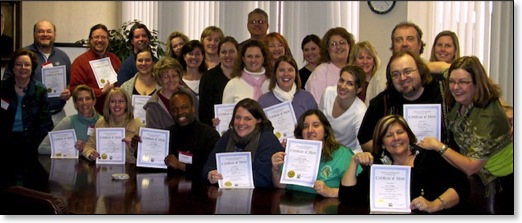
The Business Basics class was followed by a 3-Day Business Workshop, which moved in on Monday of last week. As you can see, we really enjoyed ourselves. Carol and I are shown with the class giving the business equivalent of a secret handshake. To learn what it’s all about, you’ll have to attend the next SMS 3-Day Business Workshop, which will take place in Atlanta on March 23-25 and will be taught by Carol Andrews and Julia Woods. I believe there are one or two spaces left.

In the image below, Carol is deep in conversation with class member Fima Gelman. I generally don’t single out a photographer for comment, but I doubt if the rest of the class would mind: we all got a tremendous kick out of Fima, whose sense of humor makes him a most compelling character. Fima has a great story, as he immigrated to the United States when he was 17 years old. The Gelman family came here, by way of Israel, from their homeland in the Ukraine. You can see Fima’s gift of finding and expressing humor at San Francisco-area weddings by logging onto his website. From the home page click on Weddings, then click on Humor. I enjoyed looking at the rest of the site, especially the section entitled Project Hope, which displays Fima’s photographic essay about Siberia’s orphaned children. Great work, Fima!
